Initial Threadwork
![]() Click
here to return to the Rod Builders Main Table of Contents
Click
here to return to the Rod Builders Main Table of Contents
Ok this is another major section and is one of the main indicators of defining a quality rod. On a short stroker like the one we are building there is NO room for fancy wraps, these were really the mainstay of expensive Game chair rods and although they look alright are becoming a bit dated and out of fashion, that's my personal opinion. They were also another means of increasing the cost of the rod and increasing the profit to the builder - not that that is a problem as we all need to earn a living. However as I said earlier these were for game chair rods and we are going to keep up our rod simple and very stylish.
Now this is the difference between a professionally built purchased rod and your rod. With your rod there is no cost for labour, that means you can spend the extra time building it, to a point where it would become commercially unviable for a pro rod builder to put in the same effort without charging the earth.
Ok, I have built quite a few rods and this is the basis of my thread work, I always thread the whole rod, it covers up marks and scratches on the blank and any other little mishaps, but also adds a touch more strength and class to the blank. The rule of thumb on a game rod is single thread under bound double thread over bound. that is one layer of thread for the guides to sit on and two layers of thread to secure the guides to the blank.
Ok, the first step in this project was to work out a colour scheme for the rod, I therefore chose black, blue inserts under the guides and gold thread as a highlighter.
The next step is to mark the guide centres. Now this spacing arrangement should work for you. The cork handle should be 350 mm long, ( if you use a hypolon grip and its shorter make up the imaginary length say 50mm and start your measurements from there),
These distances are very important and you should try to maintain them.
Tape the guide temporarily to the blank on top of the backbone ( make sure you have them facing the right way) using your tip guide as a visual marker to line up all the guides (very important). Again make sure the guides are aligned with the tip and the curved butt section. In this case its not so important as we are only marking the guides but its good practice for later.
Now mark with your permanent fine marker, mark the start of the leading guide foot 10 mm before the actual guide and where it ends on the underside of the guide, and the start and end of the next foot, plus another 10mm either side of the initial marks to indicate the start of some highlights. Do this for every guide on the blank, and then remove the guides from the blank.
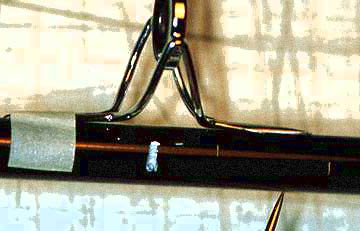 Here is an example of setting up a guide by marking it. notice how the marks
start 10mm before the guide. In our case we will mark another spot 10mm before
this again, with the same for the other foot
Here is an example of setting up a guide by marking it. notice how the marks
start 10mm before the guide. In our case we will mark another spot 10mm before
this again, with the same for the other foot
Now comes the fun, we have to thread in sections, changing colours dictates the start of a new thread section.
For a visual guide only I have borrowed some jpegs of someone starting and finalising a thread section. Remember every time we change colour we have to start up a new section and that means doing this every time, even if we are highlighting only a few mm of thread section.
Although we are showing the binding of a guide, the thread work here is the same whether you are binding a guide or just doing some section thread work
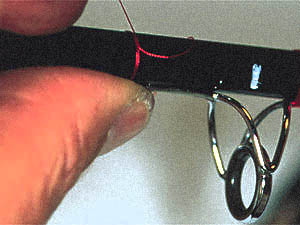
Here we start by rolling the thread over itself first so that the rolled thread is holding the loose loop.
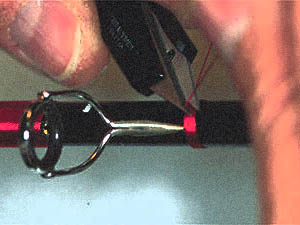
Continue with several more binds then cut off the loose tag and continue to bind over it.

At the end of your threadwork section bind over a loop of cotton as can be seen.
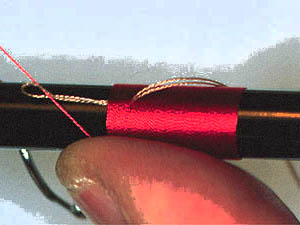
Pass the cotton thread through the loop
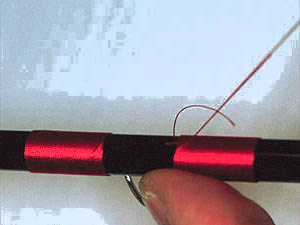
and pull the loop end though also pulling through the loose thread end, therefore securing tightly under several binds of initial thread.
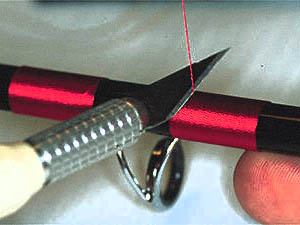
Cut off the tag end with a razor of craft scaple as shown.

roll over threadwork to help cover little gaps within the threadwork with a blunt object. I find a teaspoon or the backend of a butter knife works well.
Our Rod ready for Binding
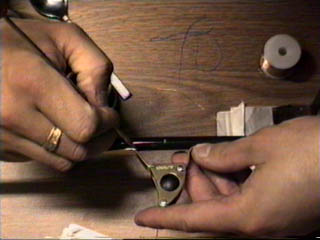 here we are marking the guide onto the rod, to know where to start and finish
the thread binding. We should already have marked the centre point earlier as
can be seen by the white mark in the middle of the guide.
here we are marking the guide onto the rod, to know where to start and finish
the thread binding. We should already have marked the centre point earlier as
can be seen by the white mark in the middle of the guide.
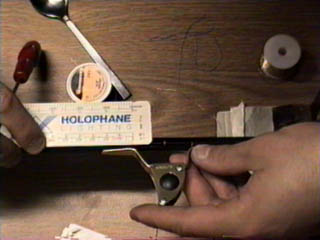
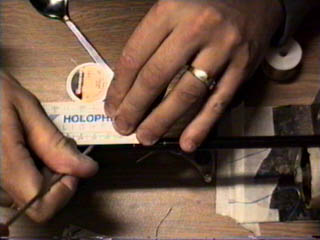
In this sequence we can see how to mark our guides. Mark the guide as stated earlier 10mm past both ends of the guide foot. Use this example on every guide in sequence.
Here we will start with an overall sequence showing the rod at a distance, the next sequence will be seen closer to the rod.
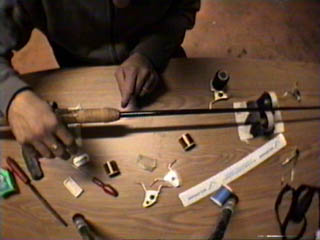
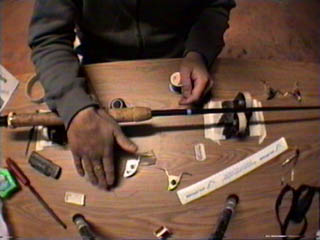
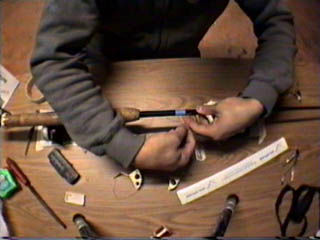

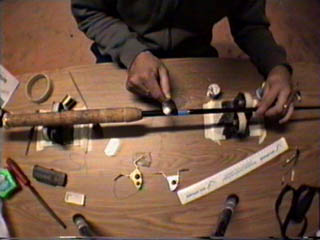
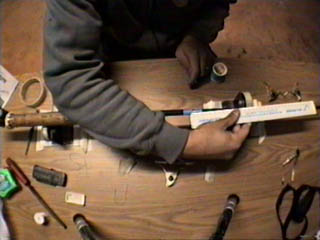
In this group of photos we can see the chain of events. In this case I started binding from the end of the cork in black to the start of where the blue section had been designated to start, which can be seen more clearly in the next sequence. I then bound in blue to within a few mm of the centre point of the guide and then bound a 5 mm gold highlight section which looks like a little gold ring. After this I continued to bind in blue to the end of the marked guide section. Although not shown here I continued to bind in black to 10mm past where the guide would finish. this can be seen more clearly on the next group of photos. It should also be noted that when I got to the end of the guide section binding in black, I bound a slight blue ring followed by a gold ring. This was also performed at the beginning of the guide closest to the cork section.


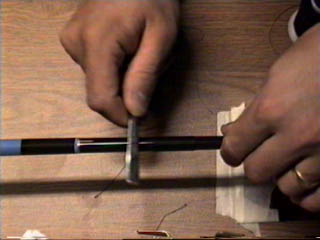
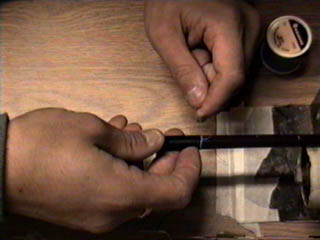
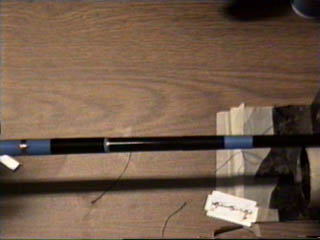
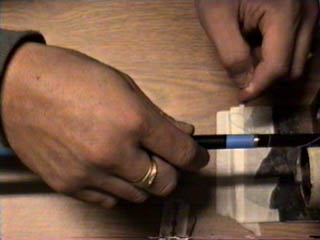
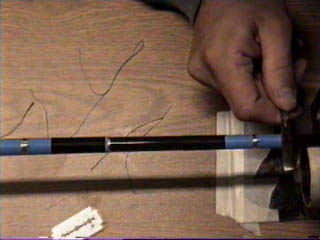


In this group of events we start off black binding at the initial guide mark (look closely to see the 5 white marks on the rod showing where the coloured thread should start and finish in the 1st picture). This binding is continued to the blue mark, again we bind to within a few mm of the centre point and bind in a gold highlighted ring, we continue with blue until the black binding mark appears. At this stage and throughout the binding process its a good idea to push the threads together more with the handle of a spoon or butter knife. Once we have arrived at the black binding spot offer the guide up as a check to see that the blue spans the distance allowed correctly. If needed a few adjustments may need to be made. Continue with the black binding to the designated distance and then add the blue and gold highlights to the outside of the guide bindings as seen on the 7th photo in this set.
This procedure is to be replicated for every Guide binding.
At the end of this procedure we will have a rod that has the basic under bounds for the guides to sit on. Once you have achieved this level it is then optional to bind in between the guide bindings in black so that the whole rod is thread bound. I personally favour this as I mentioned earlier, and if bound in black will not show any thread gaps once the epoxy is applied.
This is an important option and is not essential at this stage.
Once the whole rod is bound and the cork and leather work completed later in the program you can apply at this stage a holding coat of epoxy to the whole rod and allow this to fully cure. You may need to apply a single bind once again under the guide feet later or apply the guides directly to the epoxied rod. the choice is yours, but I do apply a single bind in readiness for the guide foot. This adds extra strength to the rod and is easier to bind the following 2 over binds as well as making sure that all the cotton is becoming epoxy soaked at all levels and ensuring maximum strength. If you do epoxy all the way up to the leather grip it also allows you to add a much smoother final cotton over bind to the leather foregrip as the epoxy will take up all the dips and bumps of an uneven foregrip cotton bind. You will know what I mean when you bind and build up the foregrip.